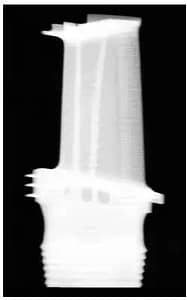Advantages and Limitations of Radiographic Testing

1. There is a direct record of the test results-negatives
Because the information recorded on the film is very rich and can be preserved for a long time, radiography becomes a kind of real, direct and traceable detection method.
2. The projection image of defect can be obtained, and the defect qualitative and quantitative is accurate. Among all kinds of nondestructive testing methods, the relative defect qualitative and quantitative is standard.
In quantitative terms, the length and width of volumetric defects (pores, slag inclusions) are also accurately determined, with an error of approximately zero mm. However, for area defects (such as cracks, non-fusion) , such as the size of defect tip (height and width of opening) is very small, the image extension on the film may be indistinguishable, and the quantitative data will be small.
3. The detection rate of volume defects is very high, but the detection rate of area defects is affected by many factors.
Volumetric defects refer to porosity and slag inclusion defects. Under normal circumstances, the diameter of the specimen thickness of more than 1% of the volume-type defects can be detected. In thin specimens, the small size of the defect detectable is limited by the eye’s resolution, up to 0.5 mm or less. Area defects are cracks, unfused defects, the factors affecting the detection rate include the size of defect shape, the thickness, the angle, the geometric condition, the type of source and film, and the sensitivity of the image quality meter. Nevertheless, it can be said that the detection rate of cracks in thick specimens is generally low, but for thin specimens, unless the crack or unfused height and the opening width are small, the film sensitivity meets the requirements as long as the photographic angle is appropriate, the crack detection rate is high enough.
4. It is suitable for the work with thin thickness but not for the work with thick thickness, because the work with thick thickness requires high energy x-ray testing equipment.
The transmission thickness of 300 kv portable X-ray machine is generally less than 42 mm. The transmission thickness of 420 kv mobile x-ray machine and IR192 γ-ray machine are both less than 100 mm, so it’s more difficult. In addition, as plate thickness increases, radiographic sensitivity decreases, which means that radiographs for thick work are more likely to miss small-size defects and some area-type defects.
5. Suitable for detecting butt welds, fillet welds detection effect is poor
It is not suitable to detect fillet welds, fillets, fillets and forgings. It is difficult to detect fillet welds. The reason why it is not suitable to inspect plates, filaments and forgings is that most of the defects in the plates and forgings are parallel to the plates and can not be detected by radiography. In addition, filamentous materials and forgings with large thickness are difficult to penetrate by rays and do not produce good results.
6. Some specimen structures and field conditions are not suitable for radiography.
Due to the penetration method, the detection needs to be close to the two sides of the work, so the structure and field conditions sometimes limit the detection. For example, containers with internals, containers with thick insulation layer, containers with internal liquid or non-emptied state media can not be detected; But only for small diameter containers, larger diameter (generally greater than 1000mm) containers, it is difficult to implement. In addition, radiography source to film distance (focal length) has certain requirements, such as the focal length is too short, the film definition will be very poor.
7. It is difficult to determine the position and size (height) of the thickness direction of the defect in the work.
In addition to some root defects can be combined with welding knowledge and rules to determine the thickness of the direction of the position in the work, many defects can not be provided with film information location. The defect height can be judged by the method of contrast of blackness, but the accuracy is not high, especially for the small crack defect in image, the blackness can not be measured accurately, and the error of the defect height is large.
8. Radiographic Testing is slow
Under normal circumstances, a directional x-ray machine transmission length of not more than 300 mm, take a picture to need 10 minutes, γ-ray source exposure time is generally longer. Radiography takes several hours from the beginning of radiography to the evaluation of the results. Compared with other nondestructive testing methods, radiographic detection is very slow and inefficient. However, special applications in special situations, such as circumferential X-ray exposure or γ-ray source panoramic exposure, can greatly improve the detection efficiency.
9. Radiation is harmful to the human body
Radiation can cause a variety of operations on human tissues, and therefore limits have been established for the dose equivalent of occupational radiation workers. It is required that the dose equivalent received by the operator should not exceed the limit value, and the absorbed dose of the operator and other personnel should be reduced as far as possible. The main protective measures are shielding protection, distance protection and time protection. Site photography will bring some problems in construction organization, especially γ-ray, and the strict regulation of radioisotopes will affect the work efficiency and cost.
Learn more our project quality managemet, QAQC and third party inspection (TPI), NDT practices thru below link.-
